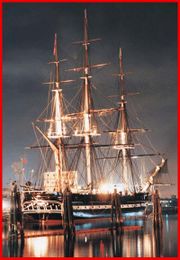US frigate Constitution
From WikiPOBia
US frigate Constitution – A 44-gun frigate of the United States Navy, launched in October 1797, and still currently a commissioned warship in the U.S. Navy.The Historical Constitution
The Constitution and five other frigates were authorized by Congress by the "Armament Act," signed into law by President George Washington on March 21, 1794. Constitution (along with her five sisters, United States, President, Constellation, Congress, and Chesapeake) was designed by naval architect Joshua Humphreys of Philadelphia. The contract for construction of Constitution was awarded to Hartt's Shipyard in Boston, Massachusetts, where her keel was laid later in 1794. She was launched on October 21, 1797, and completed at a cost of $302,700.
Constitution put to sea for the first time on July 22, 1798, under the command of Capt. Samuel Nicholson. She spent the next two years cruising the West Indies protecting American shipping interests. Between 1803 and 1805, Constitution served as flagship for the U.S. Naval squadron blockading Barbary pirates in their North-African ports.
At the outbreak of the War of 1812, Constitution had been newly overhauled at the Washington Navy Yard. Exiting the Chesapeake Bay enroute to New York, Constitution encountered a British squadron in light winds. Over the course of the next three days, Consitution's crew employed various methods to escape the pursuing British, including wetting the sails, towing the ship with the ship's boats, and "kedging" with the anchors and capstan. Taking advantage of a favorable wind, she escaped her pursuers and put into Boston.
On August 19, 1812, Constitution, still under the command of Capt. Hull, fought her famous engagement with the British frigate HMS Guerriere. The engagement lasted about two hours, and ended with Guerriere completely dismasted and so badly damaged that she could not be saved. It was during this engagement that American crewmen reportedly observed one of Guerriere's 18-pound shot bounce harmlessly off her hull, inspiring Constitution's nickname, "Old Ironsides."
Later in 1812, under the command of Capt. William Bainbridge, Constitution encountered the British frigate HMS Java off the coast of Brazil. The two ships engaged and fought for over three hours. Java struck her colors after taking 130 casualties, completely dismasted, and as with Guerriere, so badly damaged she could not be saved. Capt. Bainbridge, before sinking Java after removing survivors, salvaged Java's helm to replace Constitution's, which was shot away during the engagement.
During 1814, Constitution slipped in and out of Boston harbor twice, past the blockading British men-of-war. On February 20, 1815, under the command of Capt. Charles Stewart, Constitution simultaneously fought two British men-of-war, HMS Cyane (24) and HMS Levant (18), and captured both. While returning with her prizes to Boston, she was sighted and chased by a British squadron of frigates -- including HMS Acasta and HMS Leander. Leander and Acasta successfully re-took Levant, but Constitution and Cyane escaped into Boston.
During various tours and at various ports-of-call over her 200 year life, Constitution has hosted numerous famous visitors aboard, including the English poet Lord Byron, Pope Pius IX, and Queen Elizabeth II. As of October 2007, Constitution is undergoing an overhaul and further restoration to make her appear more closely as she did in the year 1812. She is the oldest commissioned warship afloat.
| SPOILER WARNING: Plot or ending details for "The Fortune of War" follow. |
In the Canon
Constitution is mentioned in multiple volumes of the Aubrey-Maturin series, but is featured most prominently in The Fortune of War, which contains a detailed account of her action against HMS Java off the coast of Brazil. O'Brian's description of the ships' movements during the battle appears to closely match at least one official account of the action by an officer who was present. The obvious exception is O'Brian's insertion of the fictional Jack Aubrey, who is depicted in the book as a passenger aboard Java. Aubrey, Stephen Maturin, and the surviving crew of Java are taken aboard Constitution and transported by her to Boston as prisoners of war. Seriously wounded in the battle, Aubrey sometimes occupies his time observing Constitution's post-battle repair by telescope from the window of his Boston hospital room.
References
USS Constitution Official Website, November 15, 2007 display text
Photo Credit - USS Constitution Official Website, January 1, 2008 [1]
Sam Willis, Fighting Ships, 1750-1850, (Quercus, 2007)
Dean King, A Sea of Words, Third Edition, (Henry Holt & Co. 1997) -- (Containing transcript of official report of a British officer present during Constitution vs. Java action.
Michael Phillips Ships of the Old Navy, November 15, 2007display text


